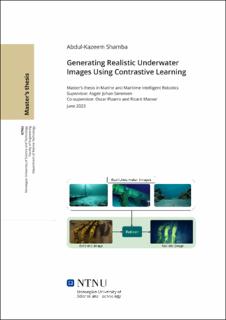| dc.description.abstract | Artificial intelligence (AI) has gained tremendous traction in the past decade, both due to improvements in computational power and the availability of a cornucopia of useful datasets. AI techniques have seen increased application in many challenging domains such as autonomous navigation, object detection, and anomaly detection. Each of these tasks presents novel challenges and requires a high level of precision and accuracy. Most of the models we have today are supervised therefore sources of good generalization capability of the model, rely heavily on large amounts of label training data. Due to the cost, time, and complexity of providing annotations, as the natural world is unannotated, there is a need for a learning technique for generating realistic images from synthetic input while preserving the contents. Currently, the generation of realistic underwater images relies on complex physics-based models and extensive parameter adjustments, requiring domain knowledge of the underwater environment. In this thesis, we investigate the use of contrastive learning and generative adversarial network to build an end-to-end neural network for generating realistic underwater images from a set of uniform lighting synthetic inputs conditioned on real underwater images. We use the contrastive loss to preserve the content of the generated images and modify our model architecture to account for 4-channel RGBD input. After performing inference on 190 uniform lighting images from the Vision Autonomous Robots for Ocean Sustainability (VAROS) synthetic underwater data environment and computing the Fréchet inception distance (FID), we conclude that our model produced compelling realistic underwater images that can rival the physics-based images from the VAROS synthetic underwater dataset. Our statistical analysis of the FID suggests that using contrastive loss to replace the cycle-consistent loss of CycleGAN and the inclusion of depth information resulted in the highest FID when compared to other baselines for unpaired image translation. In conclusion, the creation of realistic synthetic underwater images provides numerous advantages for marine robotics practitioners and researchers. These images enable practitioners to test and optimize their specialized equipment in a controlled environment, ensuring accurate performance and functionality before deployment in real-world underwater settings. | |
